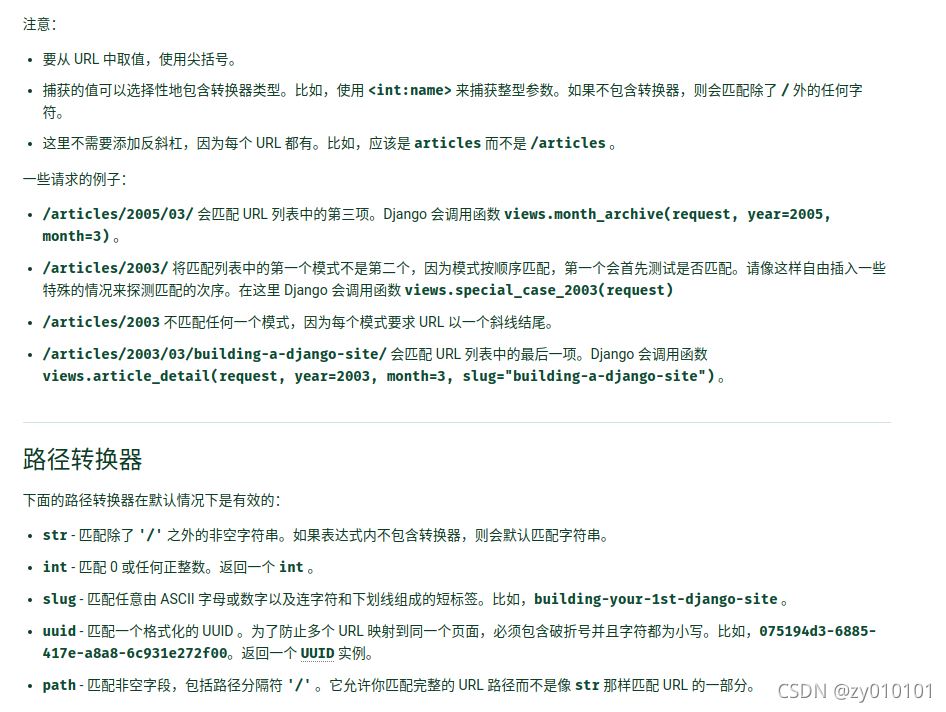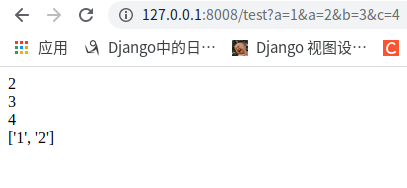Python Django獲取URL中的數據詳解
Django獲取URL中的數據
URL中的參數一般有兩種形式。如下所示:
1. https://zy010101.blog.csdn.net/article/details/120816954 2. https://so.csdn.net/so/search?q=Django&t=blog&u=zy010101
我們將第一種形式稱為“URL路徑參數”;第二種形式稱為“URL關鍵字形式”。下面講述如何在Django中獲取這兩種形式的數據。
URL路徑參數
使用path函數
from django.urls import path
from . import views
urlpatterns = [
path('articles/2003/', views.special_case_2003),
path('articles/<int:year>/', views.year_archive),
path('articles/<int:year>/<int:month>/', views.month_archive),
path('articles/<int:year>/<int:month>/<slug:slug>/', views.article_detail),
]
關於這段URL的解釋說明,直接參考Django官方文檔即可。
為瞭防止有時候進不去文檔,我將官方文檔也直接貼在下面:

使用re_path函數
如果,使用path函數並不能滿足你匹配URL的要求,那麼可以使用re_path函數來使用正則表達式來匹配URL路徑中的參數。需要註意在Django中,使用正則表達式來獲取分組中的值的語法是(?P<name>pattern),其中 name 是組名,pattern 是要匹配的模式。
from django.urls import path, re_path
from . import views
urlpatterns = [
path('articles/2003/', views.special_case_2003),
re_path(r'^articles/(?P<year>[0-9]{4})/$', views.year_archive),
re_path(r'^articles/(?P<year>[0-9]{4})/(?P<month>[0-9]{2})/$', views.month_archive),
re_path(r'^articles/(?P<year>[0-9]{4})/(?P<month>[0-9]{2})/(?P<slug>[\w-]+)/$', views.article_detail),
]
這段URL配置的說明可以參考使用正則表達式
同樣,為瞭防止有時候進不去文檔,我將官方文檔也直接貼在下面:

需要特別註意的是,正則表達式進行匹配之後,捕獲的參數都作為字符串傳遞給視圖函數(視圖類)。
URL關鍵字形式
通常,除瞭在URL路徑中傳遞數據,也可以在URL參數中進行數據傳遞。例如:
http://www.demo.com/index?keys=123&values=qwe
這段URL傳遞瞭參數keys和values,它們的值分別是123,qwe.
在此之前,先來介紹一下前備條件QueryDict。
HttpRequest對象的屬性GET、POST都是QueryDict類型的對象
Django獲取URL關鍵字參數可以通過HttpRequest.GET屬性來獲取。例如:
def test(request):
a = request.GET.get("a")
b = request.GET.get("b")
c = request.GET.get("c")
a_all = request.GET.getlist("a")
res = a+'<br>'+b+'<br>'+c+'<br>'+str(a_all)
return HttpResponse(res)
現在使用如下的URL進行請求:
http://127.0.0.1:8008/test?a=1&a=2&b=3&c=4
頁面顯示如下所示:

查詢字符串不區分請求方式,即假使客戶端進行POST方式的請求,依然可以通過request.GET獲取請求中的查詢字符串數據。
總結
本篇文章就到這裡瞭,希望能夠給你帶來幫助,也希望您能夠多多關註WalkonNet的更多內容!
推薦閱讀:
- Django框架之路由用法
- Django中url與path及re_path的區別說明
- Django url 路由匹配過程詳解
- Django路由層如何獲取正確的url
- Django URL和View的關系說明